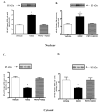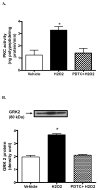Role of nuclear factor kappa B (NF-kappaB) in oxidative stress-induced defective dopamine D1 receptor signaling in the renal proximal tubules of Sprague-Dawley rats
- PMID: 17320758
- PMCID: PMC2696818
- DOI: 10.1016/j.freeradbiomed.2006.11.033
Role of nuclear factor kappa B (NF-kappaB) in oxidative stress-induced defective dopamine D1 receptor signaling in the renal proximal tubules of Sprague-Dawley rats
Abstract
Dopamine promotes sodium excretion, in part, via activation of D1 receptors in renal proximal tubules (PT) and subsequent inhibition of Na, K-ATPase. Recently, we have reported that oxidative stress causes D1 receptor-G-protein uncoupling via mechanisms involving protein kinase C (PKC) and G-protein-coupled receptor kinase 2 (GRK 2) in the primary cultures of renal PT of Sprague-Dawley (SD) rats. There are reports suggesting that redox-sensitive nuclear transcription factor, NF-kappaB, is activated in conditions associated with oxidative stress. This study was designed to identify the role of NF-kappaB in oxidative stress-induced defective renal D1 receptor-G-protein coupling and function. Treatment of the PT with hydrogen peroxide (H(2)O(2), 50 microM/20 min) induced the nuclear translocation of NF-kappaB, increased PKC activity, and triggered the translocation of GRK 2 to the proximal tubular membranes. This was accompanied by hyperphosphorylation of D1 receptors and defective D1 receptor-G-protein coupling. The functional consequence of these changes was decreased D1 receptor activation-mediated inhibition of Na, K-ATPase activity. Interestingly, pretreatment with pyrrolidine dithiocarbamate (PDTC, 25 microM/10 min), an NF-kappaB inhibitor, blocked the H(2)O(2)-induced nuclear translocation of NF-kappaB, increase in PKC activity, and GRK 2 translocation and hyperphosphorylation of D1 receptors in the proximal tubular membranes. Furthermore, PDTC restored D1 receptor G-protein coupling and D1 receptor agonist-mediated inhibition of the Na, K-ATPase activity. Therefore, we suggest that oxidative stress causes nuclear translocation of NF-kappaB in the renal proximal tubules, which contributes to defective D1 receptor-G-protein coupling and function via mechanisms involving PKC, membranous translocation of GRK 2, and subsequent phosphorylation of dopamine D1 receptors.
Figures






Similar articles
-
Oxidative stress causes renal dopamine D1 receptor dysfunction and hypertension via mechanisms that involve nuclear factor-kappaB and protein kinase C.J Am Soc Nephrol. 2007 May;18(5):1446-57. doi: 10.1681/ASN.2006121373. Epub 2007 Apr 4. J Am Soc Nephrol. 2007. PMID: 17409305
-
Hydrogen peroxide causes uncoupling of dopamine D1-like receptors from G proteins via a mechanism involving protein kinase C and G-protein-coupled receptor kinase 2.Free Radic Biol Med. 2006 Jan 1;40(1):13-20. doi: 10.1016/j.freeradbiomed.2005.08.018. Epub 2005 Sep 8. Free Radic Biol Med. 2006. PMID: 16337875
-
Tempol reduces oxidative stress and restores renal dopamine D1-like receptor- G protein coupling and function in hyperglycemic rats.Am J Physiol Renal Physiol. 2006 Jul;291(1):F58-66. doi: 10.1152/ajprenal.00362.2005. Epub 2006 Feb 14. Am J Physiol Renal Physiol. 2006. PMID: 16478977
-
Renal dopamine receptor signaling mechanisms in spontaneously hypertensive and Fischer 344 old rats.Clin Exp Hypertens. 1999 Jan-Feb;21(1-2):25-36. doi: 10.3109/10641969909068646. Clin Exp Hypertens. 1999. PMID: 10052639 Review.
-
Dopamine-1 receptor G-protein coupling and the involvement of phospholipase A2 in dopamine-1 receptor mediated cellular signaling mechanisms in the proximal tubules of SHR.Clin Exp Hypertens. 1997 Jan-Feb;19(1-2):131-40. doi: 10.3109/10641969709080810. Clin Exp Hypertens. 1997. PMID: 9028641 Review.
Cited by
-
Dopamine, Immunity, and Disease.Pharmacol Rev. 2023 Jan;75(1):62-158. doi: 10.1124/pharmrev.122.000618. Epub 2022 Dec 8. Pharmacol Rev. 2023. PMID: 36757901 Free PMC article. Review.
-
Reactive oxygen species and dopamine receptor function in essential hypertension.Clin Exp Hypertens. 2009 Apr;31(2):156-78. doi: 10.1080/10641960802621283. Clin Exp Hypertens. 2009. PMID: 19330604 Free PMC article. Review.
-
Role of H(2)O(2) in hypertension, renin-angiotensin system activation and renal medullary disfunction caused by angiotensin II.Br J Pharmacol. 2012 Aug;166(8):2386-401. doi: 10.1111/j.1476-5381.2012.01957.x. Br J Pharmacol. 2012. PMID: 22452317 Free PMC article.
-
Inflammation compromises renal dopamine D1 receptor function in rats.Am J Physiol Renal Physiol. 2009 Dec;297(6):F1543-9. doi: 10.1152/ajprenal.00366.2009. Epub 2009 Sep 30. Am J Physiol Renal Physiol. 2009. PMID: 19794106 Free PMC article.
-
Novel role of NF-κB-p65 in antioxidant homeostasis in human kidney-2 cells.Am J Physiol Renal Physiol. 2012 Jun 1;302(11):F1440-6. doi: 10.1152/ajprenal.00006.2012. Epub 2012 Mar 7. Am J Physiol Renal Physiol. 2012. PMID: 22397926 Free PMC article.
References
-
- Jose PA, Eisner GM, Felder RA. Renal dopamine receptors in health and hypertension. Pharmacol Ther. 1998;80:149–182. - PubMed
-
- Aperia AC. Intrarenal dopamine: a key signal in the interactive regulation of sodium metabolism. Annu Rev Physiol. 2000;62:621–647. - PubMed
-
- Hegde SS, Jadhav AL, Lokhandwala MF. Role of kidney dopamine in the natriuretic response to volume expansion in rats. Hypertension. 1989;13:828–834. - PubMed
-
- Hussain T, Lokhandwala MF. Renal dopamine receptor function in hypertension. Hypertension. 1998;32:187–197. - PubMed
-
- Beheray S, Kansra V, Hussain T, Lokhandwala MF. Diminished natriuretic response to dopamine in old rats is due to an impaired D1-like receptor-signaling pathway. Kidney Int. 2000;58:712–720. - PubMed
Publication types
MeSH terms
Substances
Grants and funding
LinkOut - more resources
Full Text Sources

